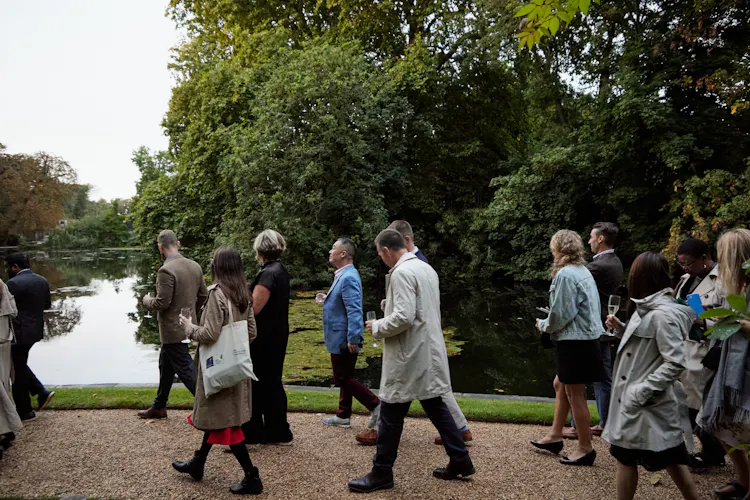
Close
result
INSIGHT
Tending the lily pond
Tending the lily pond
David Byrum
6 min read

David Byrum explores the unique role of the chief of staff in aligning culture and climate.
A metaphor often used when talking about organisational culture is that suggested by Professor Schein in early editions of his seminal book Organizational Culture and Leadership: the iceberg. Culture is like the part of the iceberg that is under the water – it is hard to see, it is not obvious, and yet it represents 90% of the critical mass of the ice mountain and dictates how the iceberg responds to ocean currents.
The part above the water represents the organisational climate – how people feel about being part of the organisation (this includes employee engagement, satisfaction and other individual level outcomes of culture) and what they think they see going on (teamwork, influence, clarity of purpose, perceptions of fairness and equity, diversity management etc.). The above-water organisational climate is easy to see, and shipping vessels can develop strategies around ‘using it’ – avoiding it and maintaining a safe course. But captains and navigators need to be aware of the possibility that the underwater section may well protrude beyond the outer edges of the surface part, so they cannot assume that what is under the surface is the same shape as that above the surface.
It is a strong image, and yet there is something threatening about it. After all, the first association that many of us make with an iceberg is the sinking of the Titanic. Perhaps this is why, in later editions, Professor Schein introduced a new metaphor – the lily pond. Like the iceberg, the lily pond has something going on at the surface level that you can see. In this analogy, the lily farmer can feed and tend the lilies and see how well they are growing. The farmer can judge the quality of the colour and the size in their efforts to grow the very best lilies. But what the lily farmer cannot see so easily is what is going on under the surface. Are there toxic algae growing on the river or lake floor? What is the quality of the water that feeds into the river or lake? Is there something going on down there that could destroy the lilies? Will the river or lake provide a sustainable long-term base for lily farming?
An important aspect of this new metaphor is that it recognises that culture can and does change. Although what’s going on beneath the surface may not be obvious, it can be ‘managed’, and strategies can be put in place to improve it, if necessary. The metaphor also allows us to see more clearly where the chief of staff is uniquely positioned to monitor and manage the relationship between culture and climate – and what they can do if they sense that things are in danger of coming unstuck.
Key cultural foundations such as purpose, mission, vision, and values are typically agreed by senior leadership and ratified by the board before being cascaded down through the organisation via whatever communications channels are available. Even at an early stage, it is useful to have someone to ‘sense check’ and challenge this formal articulation of what senior figures believe and want the organisational culture to be. For example, if vision and mission statements are all oriented towards shareholder wealth, however much management may try to insist that ‘customer service’ is a core value and an integral part of the organisation’s culture, people will continue to believe that it’s all about profitability. Or perhaps the organisation has launched its core values with great fanfare and publicised them on the website and all over office walls and elevators; but when asked, top executives can’t even remember what they are. If top teams do not spot these contradictions themselves, the chief of staff is probably the only person with the right level of influence and – crucially – diplomatic skills to suggest that they rethink.

The executive leadership is also responsible for the organisation’s structure, which allows people to have influence, get involved, be empowered and contribute to how the organisation functions. Can people influence what goes on in the organisation? Are their ideas listened to? Are their opinions asked? Is authority centralised or decentralised? How much influence at various levels of the organisation do people have? All of these send a message regarding how people should behave. For example, an organisation reaps the benefits of economic efficiencies from a highly centralised structure, but then expects people at lower levels to use their initiative and take accountability, when the structure actually reinforces the notion that they are not trusted to make decisions. Structure is shaped by strategy, which means that, in many organisations, it is developed without reference to culture. Some chiefs of staff are actively involved with strategy development, and certainly most will be part of the conversations around implementation, if only when talking to their principals. In these conversations, the chief of staff needs to be a champion for culture, asking critical questions about the implications of new structures for staff understanding about what is important in the organisation and about how they will be expected to ‘get things done’.
Elsewhere in the organisation, Human Resource (HR) systems are powerful reinforcement mechanisms for sending messages about culture. What gets rewarded and what gets punished? Who gets promoted? How do people get promoted? How are opportunities made available? How does the organisation monitor and reinforce performance? Can people rely on good performance being recognised and rewarded, or are mistakes emphasised and blame prevails? HR leaders can be powerful partners for the chief of staff in ensuring that systems are fully aligned with the desired culture. This can strengthen employee engagement and create a positive climate as everyone in the organisation is seen to ‘walk the talk’. The chief of staff can also be a valuable ally for HR departments when it comes to the prickly problem of people who perform well but behave badly. It can be hard to leaders to restrain or let go of star performers as they frequently only see headline results, and miss, perhaps, the high turnover of junior staff around these people or the strained atmosphere in meetings. The chief of staff, with a direct line to their principal and unconstrained by formal reporting mechanisms, can paint a fuller picture of what is going on behind the numbers.
More generally, how leaders lead and how managers manage is at the very heart of organisational culture. Do managers and leaders role model excellence, do they facilitate peoples’ ability to achieve, and do they work together to illustrate collective effort? For example: top management want to build a sense of ‘one organisation’, but downwards communication is all about how each division or business unit is performing, reinforcing the siloed business. Many leaders and managers talk about the importance of culture, but their own behaviour doesn’t genuinely role model the values and desired behaviours they espouse. Again, it is difficult to imagine any individual who could address these issues apart from the chief of staff. Where there is a separate communications department, the head of that department will be another partner or ally for the chief of staff in positive reinforcement of organisational culture.
Climate tells you what people think they see going on and how they feel about it. Culture tells you how people believe they are expected to behave when doing their jobs and dealing with each other.
Climate is an important indicator of current effectiveness; culture will tell you how well your organisation can sustain that effectiveness over time. There are famous examples of organisations having a great climate and being seen to perform very well at a certain point in time, but eventually coming unstuck because of their organisation’s culture.
With the chief of staff’s freedom of movement and, typically, exceptional people skills, they monitor above and below the waterline to ensure that both the waterlilies and the culture in which they grow are healthy. They adopt the different roles of challenger, champion, and partner to HR and communications to integrate culture and climate so that they work together to help foster high performance and long-term success.

David Byrum
Managing Director, Human Synergistics Australia
Prior to joining Human Synergistics David was a principal partner with Kepner Tregoe, holding senior leadership positions including Regional Managing Director for Kepner Tregoe Australasia, Representative Director for Kepner Tregoe Japan, and a member of the global leadership team. David commenced his career with Pilkington PLC and worked in both Australia and United Kingdom. He brings to his clients over 30 years of industry experience across all industry sectors, from the boardroom to the frontline. In addition to leading the team for Human Synergistics Australia, David now provides coaching to board and executive teams at both a group and individual level to enhance their effectiveness using constructive behaviours.
David graduated from the University of Sydney with a Bachelor of Science, Honours Degree, and a Master’s in Business Administration from Deakin University. David is also a graduate of the Australian Institute of Company Directors and is a member of the Human Synergistics Australia board.








